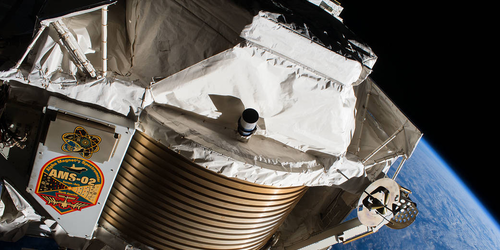A Puzzling Excess of Cosmic Deuterons
From its perch aboard the International Space Station, the Alpha Magnetic Spectrometer (AMS) has detected the signals of 2.3 x 1011 cosmic rays of various particles since its installation in May 2011. Now an analysis of those signals by the AMS team has discovered that 2.1 x 107 of those particles are deuterons [1]. AMS team lead Samuel Ting of the Massachusetts Institute of Technology says the observation suggests that a high number of high-energy cosmic-ray deuterons are streaming from some currently unknown source. That conclusion awaits confirmation.
Models predict that deuterons were created shortly after the big bang, once the temperature was low enough for protons to fuse with neutrons but still high enough that the deuterons couldn’t subsequently fuse into helium-4 ions. The window’s brevity—just 10 minutes—accounts for deuterons’ low cosmic abundance: for every atom of hydrogen there are only 0.00002 deuterons.
It’s unclear how many of those original deuterons have since acquired a cosmic-ray-level energy from a supernova blast or from some other cosmic accelerator. But even if they all have, their small number is insufficient to account for the high number of deuteron cosmic rays that AMS has tallied.
It’s long been presumed that nearly all deuteron cosmic rays are in fact produced when helium-4 ions slam into atoms of the interstellar medium. This process also produces helium-3 cosmic rays. So for the presumption to be correct, the cosmic-ray fluxes of deuterons and helium-3 ions measured by the AMS should correlate with the helium-4 flux in the same way. But analysis of the data by the AMS team finds that a large fraction of the deuterium flux has a distinctly different correlation. Ting says the finding potentially implies that there is another, “primary” source of deuteron cosmic rays.
–Charles Day
Charles Day is a Senior Editor for Physics Magazine.
References
- M. Aguilar et al. (AMS Collaboration), “Properties of cosmic deuterons measured by the Alpha Magnetic Spectrometer,” Phys. Rev. Lett. 132, 261001 (2024).




